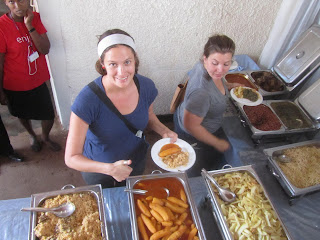Though we live in Kigali, Rwanda's capital city, Bethany will be doing work with each of the three sites where Partners In Health runs a hospital. It sounds like the one she'll visit most often is the Rwinkwavu site. She was there a couple of days last week and I came with her this week.
PIH Sites in Rwanda
 Burera District:
• 150-bed Butaro Hospital
• 15 health centers
Burera District:
• 150-bed Butaro Hospital
• 15 health centers
Southern Kayonza District:
• 110-bed Rwinkwavu Hospital
• 8 health centers
Kirehe District:
• 120-bed Kirehe Hospital
• 14 health centers
The Rwinkwavu site (or Rwink in PIH-speak) is about 87 kilometers (54 miles) from our house in Kigali (Remera Neighborhood). It took us about 1 hour and 45 minutes to drive to on the way here, though I'm convinced I could have cut 30 minutes off that time if I was driving :-)
Here's a link to a satellite view.

There are some hospital buildings just up the hill from the road, and then a large administrative building above the hospital. There are a series of dormitories just south of the complex, which is where we're staying, in a VIP room with our own bathroom. They've just built a new maternity building near the hospital and are almost done with another admin building next to the first. Bethany will have an office in the new building, which we saw when we toured it yesterday. Currently, she works out of the central dining area in the admin building, which has wireless and an amazing view overlooking the valley below and the hills beyond. There is a TV in this area and I watched a re-play of the Sweden - France game (
which had an AMAZING goal by Sweden's Ibrahimovic in case you missed it - unfortunately all links on YouTube have been made inactive because of UEFA copyright claims) with some of the employees and people in for a training while I participated in a webinar on my laptop. It was a very strange experience as I spoke with two people in the U.S. and one in Brazil while watching a game from Europe using very modern technology while looking out over the valley and not really seeing a single electric light for miles in any direction.

For the most part, all meals are communal, with staff getting food either from the hospital (for lunch) or one of two large houses in the area (breakfast and dinner). The picture below shows Bethany and some friends at lunch yesterday, which was great. Sounds like most meals are rice and beans heavy. Lunch yesterday included french fries (or chips, as they're called here) and some steamed banana dish (
called Matoke I believe), which Bethany really likes. Dinner last night was more rice, beans, matoke and a salad fresh from one of the PIH-er's garden complete with fresh bib lettuce, onions, avocado, and boiled eggs. Breakfast was some bread, coffee, and a very yummy onion and cheese omelet.

I've had some work to do, so I've spent a lot of my time on the computer, but also got in a nap in the grass overlooking the beautiful scenery. I listened to a few Kinyarwanda (local dialect) lessons, though I can't say I remember much beyond "Muraho" (hello). There are lots of birds everywhere I've been in Rwanda so far. I really like the large raptors that fly overhead sometimes, but haven't been able to get a good picture. The small bird below is one that kept visiting me while I was playing on my computer. Have no idea what kind it is, but he seemed friendly.



Post-Thursday Lunch Update: Bethany requested that I post my pictures from today's lunch as well. We had rice, matoke, and some peas with eggplant (a small, local eggplant that is a little bitter). We ate with some of the employees and I checked out the cooking area. They make huge pots of food when they cook and have set-ups to do many at the same time. Pretty impressive.

Afterwards, we walked down to one of the local bars (one of the two) and had two Cokes. 400 RWF each for the 30 cl size and they were cold (the one I had yesterday was the same price, 50 cl size, but un-refrigerated).































